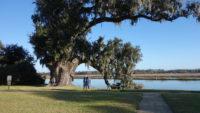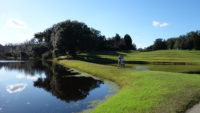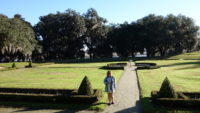 Poor Meredith was in charge today, and she did her research. Despite that, the places she wanted to go for breakfast, supper, and dessert were all unexpectedly closed (despite what their websites said). But I still managed to have a very southern day, with biscuits, chicken, and pralines on my menu for the day.
Poor Meredith was in charge today, and she did her research. Despite that, the places she wanted to go for breakfast, supper, and dessert were all unexpectedly closed (despite what their websites said). But I still managed to have a very southern day, with biscuits, chicken, and pralines on my menu for the day.
The major sight we went to see today was an unqualified success, though. We drove out to Middleton Place, a rice plantation that had been with the Middletons for four generations, which included a signer of the Declaration of Independence. Even after the fourth Middleton passed away, the estate still stayed in the family, with the last private owner creating a non-profit foundation to care for the place in the 1970s.
 The original plantation was huge – over ten square miles, and after trying several crops that didn’t pan out, the owner finally settled on rice, which grew very well and made the already wealthy Middletons even richer. Rice is a labor-intensive crop, so the plantation had at least one hundred slaves on the property. The historical placards around the grounds tried to give as much information on the enslaved population as historians have been able to uncover, as well as trying to cover the Middletons themselves and how rice was grown in the area.
The original plantation was huge – over ten square miles, and after trying several crops that didn’t pan out, the owner finally settled on rice, which grew very well and made the already wealthy Middletons even richer. Rice is a labor-intensive crop, so the plantation had at least one hundred slaves on the property. The historical placards around the grounds tried to give as much information on the enslaved population as historians have been able to uncover, as well as trying to cover the Middletons themselves and how rice was grown in the area.
The estate is gorgeous. The first Middleton decided to make the grounds his showpiece, and adapted French formal gardens to work for his terrain. The gardens are laid out such that the paths reveal the sights a little at a time because of limited sightlines. The rest of the garden always seems to be around the corner or behind a hedgerow.
 The showstopper sight is the line where the main house used to stand (it was burned down at the end of the Civil War). The house looked over a long lawn that went down terraced grounds to two reflecting ponds that led the eye through the trees to the river that flowed in a line away from the house. And even in late December, there were still blooming shrubs and flowers about.
The showstopper sight is the line where the main house used to stand (it was burned down at the end of the Civil War). The house looked over a long lawn that went down terraced grounds to two reflecting ponds that led the eye through the trees to the river that flowed in a line away from the house. And even in late December, there were still blooming shrubs and flowers about.
We did tour the remaining house structure – the main house used to be flanked by two smaller houses, and one of these was only damaged in the war, not destroyed. The Middeltons rebuilt that structure to live in as a home, and that was where someone lived until the 1970s. The house is pretty as it goes, made of red brick and two stories high, but is not especially grand. The house does have many Middleton furnishings and other possessions, including a pass that let a relative pass through the Union lines in the Civil War. It was signed by Abraham Lincoln, and is still preserved.
I n addition to the self-guided tour of the grounds, we caught three guided tours – one on slaves on the plantation, one on the animals of the estate, and one on the history of the gardens themselves. Mer and I do love guided tours for the personal storytelling style they have.
n addition to the self-guided tour of the grounds, we caught three guided tours – one on slaves on the plantation, one on the animals of the estate, and one on the history of the gardens themselves. Mer and I do love guided tours for the personal storytelling style they have.
And we did also get to pet one of the two kitties on the grounds. He was a very large tiger kitty who was very friendly. We also later saw an alligator. We did not determine if he was friendly.
We had lunch at the restaurant, which was not only open, but had the benefit of supporting the foundation to keep the estate up. We are always good at eating for a cause.
 It was a perfect day, weather-wise, with lots of sun and temperatures in the seventies. The grounds had lots of shade, including many live oaks, which have huge canopies of leaves. So we were never hot, but enjoyed the warmth very much this late in the year.
It was a perfect day, weather-wise, with lots of sun and temperatures in the seventies. The grounds had lots of shade, including many live oaks, which have huge canopies of leaves. So we were never hot, but enjoyed the warmth very much this late in the year.
We opened the place, getting there right at 9:00, and we almost closed it out, leaving around 4:30. I had seen some pictures online of Middleton Place, and I’m very glad we got to spend the day there. Spending a pretty day in beautiful surroundings is a very good thing indeed.